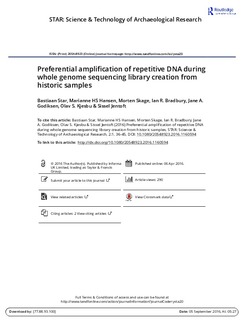| dc.contributor.author | Star, Bastiaan | |
| dc.contributor.author | Hansen, Marianne Helén Selander | |
| dc.contributor.author | Skage, Morten | |
| dc.contributor.author | Bradbury, Ian R. | |
| dc.contributor.author | Godiksen, Jane Amtoft | |
| dc.contributor.author | Kjesbu, Olav Sigurd | |
| dc.contributor.author | Jentoft, Sissel | |
| dc.date.accessioned | 2016-09-05T12:46:45Z | |
| dc.date.accessioned | 2016-09-21T11:32:18Z | |
| dc.date.available | 2016-09-05T12:46:45Z | |
| dc.date.available | 2016-09-21T11:32:18Z | |
| dc.date.issued | 2016-04-06 | |
| dc.identifier.citation | Science and Technology of Archaeological Research 2016 | nb_NO |
| dc.identifier.issn | 2054-8923 | |
| dc.identifier.uri | http://hdl.handle.net/11250/2409255 | |
| dc.description | - | nb_NO |
| dc.description.abstract | Repetitive microsatellite DNA forms a universal component of eukaryote genomes and specific biochemical
properties of such repeat regions may influence the outcome of laboratory protocols. The Atlantic cod (Gadus morhua)
genome contains an order of magnitude more dinucleotide repeats than the majority of vertebrates, with over eight
percent of its genome that can be classified as either AC or AG dinucleotide repeat. We find that the abundance of these
repeats can be inflated in ancient DNA (aDNA) whole genome sequencing (WGS) data generated from this species, in
particular in samples with a lower fragment length. This inflation is suppressed by a reduced number of amplification
cycles and by the inclusion of manufactured dinucleotide repeat oligonucleotides during amplification. These data
indicate that a biased amplification reaction leads to artificially high levels of AC and AG repeats. This process appears
to be particularly efficient in Atlantic cod –likely due to its high genomic content of repeats with relatively simple
sequence complexity. While the extend of such bias in other studies is unclear, we nonetheless urge caution when
quantifying repeat content in aDNA WGS data, given that amplification bias can be difficult to detect if this process
affects more complex repeat structures than dinucleotide repeats. | nb_NO |
| dc.language.iso | eng | nb_NO |
| dc.publisher | Taylor & Francis | nb_NO |
| dc.rights | Navngivelse 3.0 Norge | * |
| dc.rights.uri | http://creativecommons.org/licenses/by/3.0/no/ | * |
| dc.title | Preferential amplification of repetitive DNA during Next Generation Sequencing library creation of ancient DNA | nb_NO |
| dc.type | Journal article | nb_NO |
| dc.type | Peer reviewed | nb_NO |
| dc.date.updated | 2016-09-05T12:46:44Z | |
| dc.subject.nsi | VDP::Matematikk og naturvitenskap: 400::Basale biofag: 470::Genetikk og genomikk: 474 | nb_NO |
| dc.subject.nsi | VDP::Mathematics and natural scienses: 400::Basic biosciences: 470::Genetics and genomics: 474 | nb_NO |
| dc.source.pagenumber | 36-45 | nb_NO |
| dc.source.volume | 2 | nb_NO |
| dc.source.journal | STAR: Science & Technology of Archaeological Research | nb_NO |
| dc.source.issue | 1 | nb_NO |
| dc.identifier.doi | 10.1080/20548923.2016.1160594 | |
| dc.identifier.cristin | 1375809 | |

